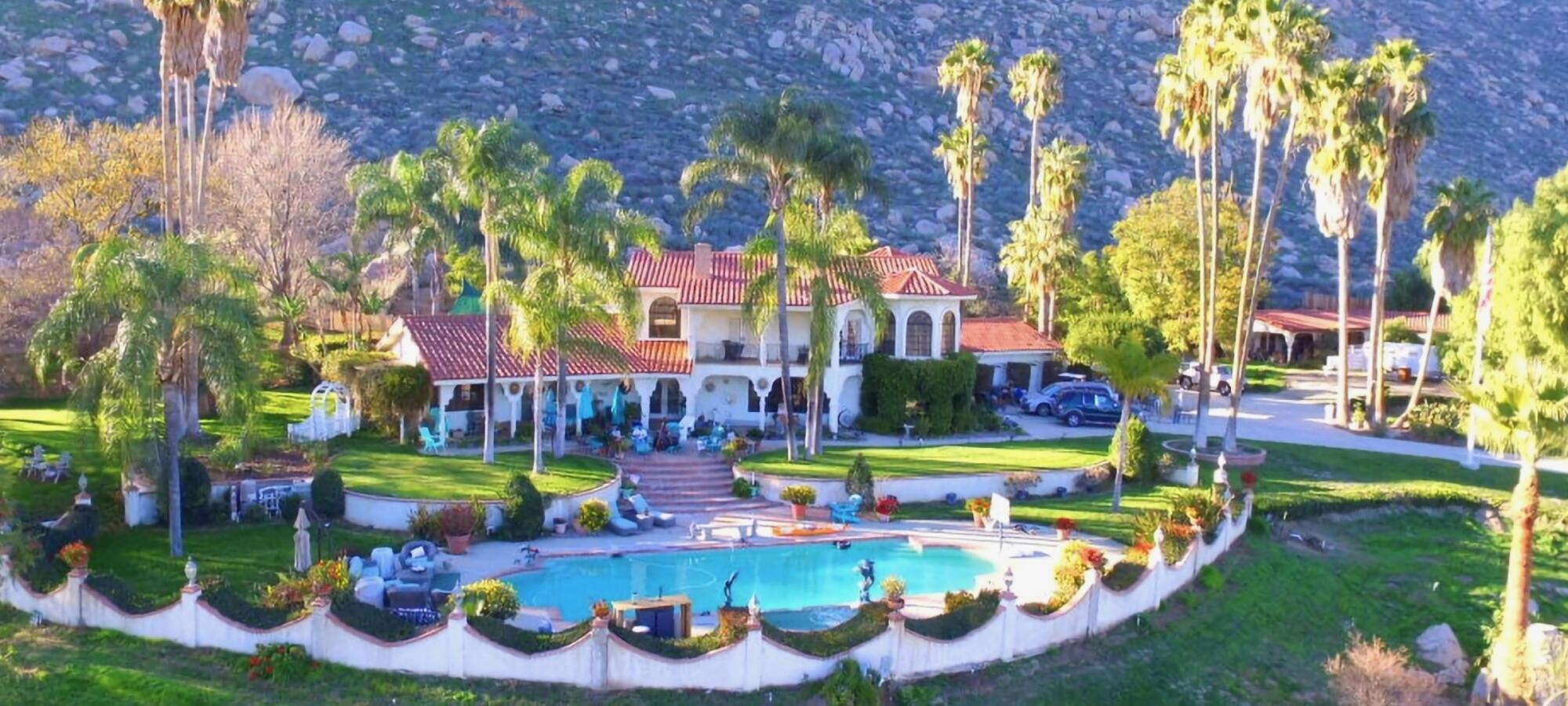DeeAnn Noland has crafted her own slice of paradise in Southern California.
Her property is perched in the hills, overlooking the city below. It spans nearly 7 acres and feels more like a resort than a home, boasting a 6,000-square-foot Spanish-style villa and a swimming pool topped by palm trees.
Her dream house isn’t found in Beverly Hills or Bel-Air or Malibu.
It’s in Hemet — and it cost her $740,000.
Southern California is riddled with luxury enclaves, but it’ll cost you. As housing prices soar, some Angelenos are bailing on the big city in favor of places that are hotter, dryer and more remote, sprawling out into Riverside, San Bernardino and Kern counties in search of dirt-cheap mansions.
In L.A., $1 million might not even buy a second bedroom. A few hours outside L.A., $1 million can buy a dream house.
Noland, 67, grew up in Alhambra and bought her first house in Baldwin Park with her husband, Manuel. The tract home barely had a backyard.
Since then, she’s found the allure of open land, moving farther and farther away from city centers and buying bigger and bigger homes — mostly for the same price. Noland first landed in Cherry Valley near Yucaipa, buying a 2,600-square-foot home on an acre before buying her Hemet mansion in 2015, turning it into a tropical haven filled with horses, goats and a handful of exotic birds, including toucans and African crowned cranes.
Noland’s Hemet home includes a swimming pool, yard and room for her exotic animals.
Noland does well, but she’s far from rich. Her late husband was a civil engineer, and she breeds animals for extra income. But in Hemet, she lives like royalty.
Tucked in the San Jacinto Valley, Hemet has a median family income of $49,901, and a median home value of $444,221, according to Zillow. Five years ago, Business Insider named it the 44th most miserable city in the country, citing high poverty and crime rates.
“It’s no Beverly Hills,” said resident Eric Hernandez on a walk through the Hemet Valley Mall. “It’s a nice community, but not luxurious.”
Hernandez, 20, grew up in the area but plans to leave for a cooler climate someday.
On a Tuesday in July, the temperature ticks to 100 before noon. But Noland doesn’t mind.
“We have A/C and a pool,” she said. “Hemet has its typical problems of homelessness and crime, but I don’t spend much time in the city. I’ve gotten used to staying home.”
She’s taken the money she saved from buying in Hemet and spent it on turning the home into a place she never wants to leave.
“I can’t travel much because of the animals, so I turned various rooms into destinations,” she said.
The living room is ocean-themed. A nook in the kitchen became a rainforest loaded with plants. The den has evolved into an African safari, complete with fake zebra skins, wood-carved elephants, replica ostrich eggs and a 6-foot stuffed giraffe doll.
“We can travel without leaving the house,” she said.
There’s a reason L.A. has emerged as one of the priciest real estate markets in the country. The weather is mild, the ocean is nearby, and its wealthy enclaves cater to a luxurious lifestyle.
Take Brentwood, where homes start at $2 million and range well past $50 million. Celebrities descend from their hillside homes to shop at Brentwood Country Mart, a quaint-but-high-end mall that houses a Christian Louboutin store and Gwyneth Paltrow’s wellness chain Goop. For dinner, they can swing by Mélisse for the egg caviar or Baltaire for a filet mignon.
Luxury options are more limited in places like Ridgecrest, Palmdale and Hemet. The rich eat and shop where everyone else does, modest local joints and restaurant franchises, Targets and Walmarts and Home Depots. But some buyers are finding that the savings on buying mansions in remote areas makes up for the lack of luxury lifestyle.
“These buyers don’t need to go to Rodeo Drive, they can get things delivered. They don’t need five-star restaurants, they can do their own cooking at home,” said real estate agent Joe Napoli, based in San Dimas. “There’s a sense of ‘Been there, done that.’”
Last year, Napoli handled the sale of one of most bizarre properties ever built in Southern California: a hilltop behemoth towering over Palmdale.
Palmdale boasts a median home value of just over $500,000. Business Insider ranked it even worse than Hemet on its Most Miserable Cities list in 2019, calling it the “foreclosure capital of California” because nearly a fifth of its residents were living in poverty.
But you wouldn’t be able to tell from this place. The outside looks like a giant set of bleachers; the inside looks like a Great Wolf Lodge.
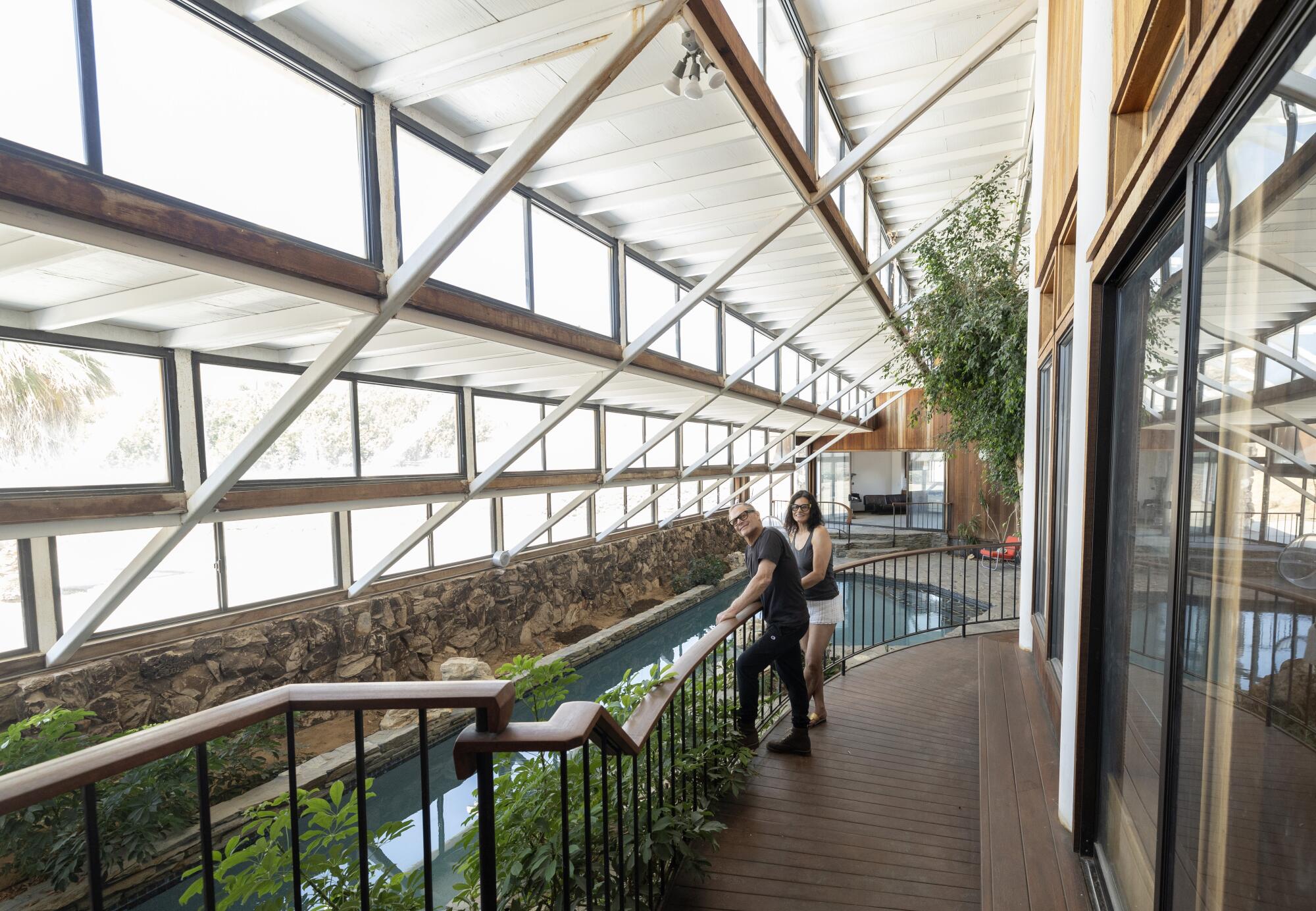
Eric and Nannette Brill inside their hilltop mansion that features is a three-story atrium and swimming pool area.
(Myung J. Chun/Los Angeles Times)
The grandiose manor is so high in the hills that Palmdale resident Rose Flores can see it from her apartment on the far side of the city.
“It doesn’t look like a house, more like a resort,” she said.
The mansion twinkles in the sun, a modern castle perched above the commoners below. Inside, it holds a massive three-story swimming pool atrium encased in glass and steel.
It was purchased by Eric and Nannette Brill in November for $1.35 million — a price that might not even buy a three-bedroom bungalow in hip L.A. neighborhoods such as Silver Lake or Highland Park.
Like Noland, the Brills had a slow, gradual journey away from the city, moving from Palos Verdes to West Covina to, eventually, Palmdale.
The pair were drawn to the grand scale and scope of the property, as well as the natural beauty of the terrain. They spend much of their time cruising around in their vintage 1972 Jeep, winding through the San Gabriel Mountains on the Angeles Forest Highway.
They don’t mind the lack of luxury shopping or five-star dining options.
“We have the best Puerto Rican and Cuban food outside of Puerto Rico at Baracoa, a restaurant just about 10 minutes away,” Eric said. “And Palmdale has several shopping centers.”
Kenward Cooper, the agent who sold them the home, said an uptick of luxury buyers flocked to the desert and mountains during the pandemic and found that the added acreage and privacy were worth the lack of lavish amenities.
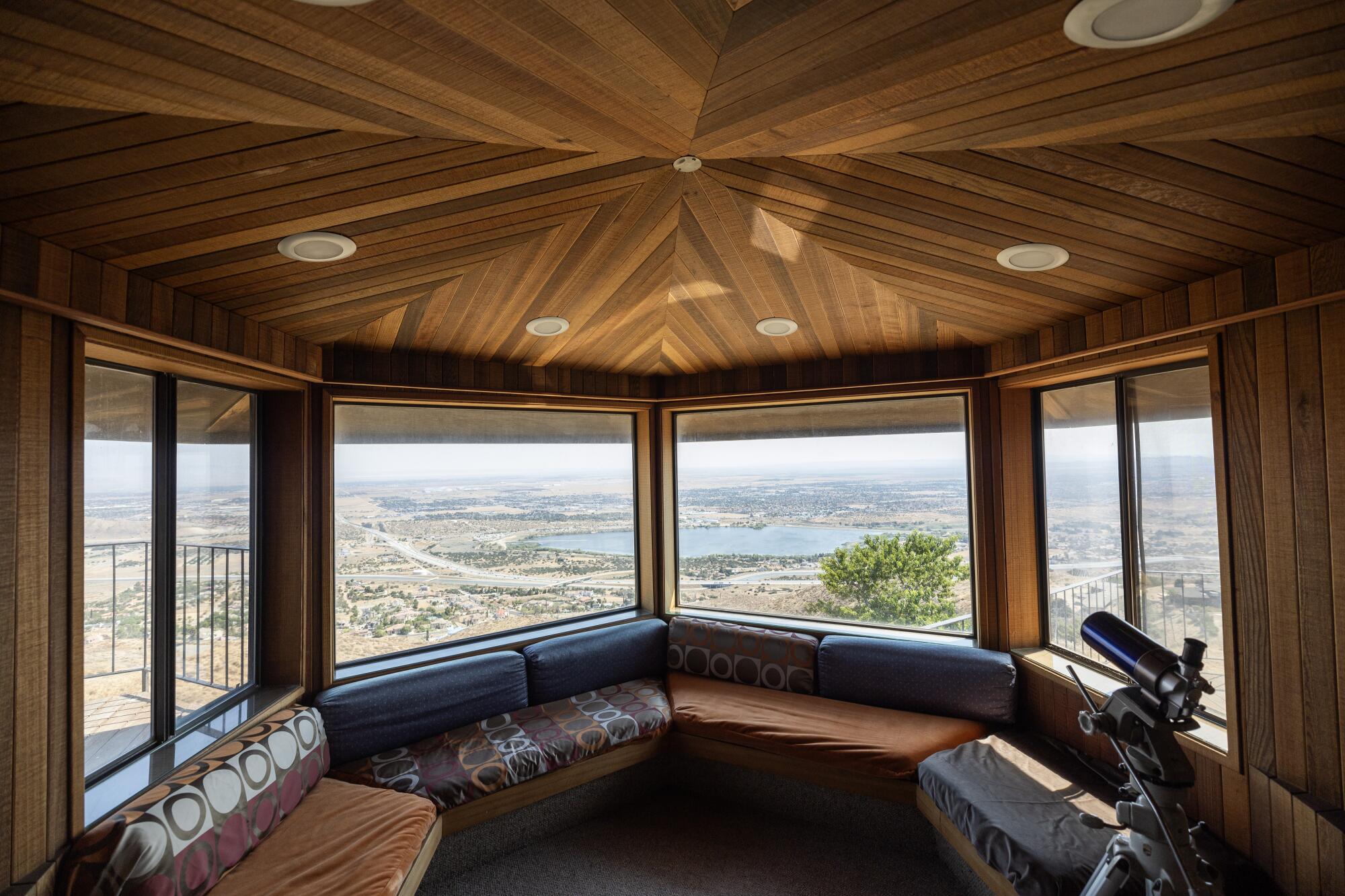
A room with a view in this J. Herbert Brownell-designed hilltop mansion above Palmdale.
(Myung J. Chun/Los Angeles Times)
“Many are willing to sacrifice that lifestyle for the types of houses they can have out here,” he said. “Plus, Palmdale just got a Sprouts Farmers Market. Let’s see what happens when Whole Foods moves in.”
Cooper said there’s a sense of pride that comes with having a big house in a small community.
“You’re a big fish in a small pond, and being the king of the hill is naturally going to be a boost to your self-esteem,” he said.
Mansions seemingly in the middle of nowhere allow their owners to jump from middle class to upper class overnight.
But that market is hard to predict. Despite the rise in buyers during the pandemic, the overall pool of people looking to spend millions to live in nonluxury enclaves is still small.
Around L.A., property values have climbed at a steady pace over the last few years, with some homes doubling or tripling in value just since the start of the pandemic. Buying real estate is typically a safe investment because the land, not the house, often holds the real value. That’s the reason the rich buy mansions just to raze them, or buy land and don’t develop it for decades.
“In L.A., the land is worth more than what you put on it,” said William Gordon, a real estate agent based in Bakersfield. “In Bakersfield, it’s the opposite. It’s all about the value of the house or the improvements.”
As a result, mansions in remote areas get larger and larger— an extra wing, a fancier pool — as owners hope to add to the property’s value down the line. But it might be hard to find another fish big enough in the small pond able to swallow the price tag.
In a bigger city like Bakersfield, with its oil and agricultural interests, there is more demand for palatial homes. In 2017, Gordon listed a 9,595-square-foot mansion there. The seller wanted to downsize. The buyer, a local surgeon, wanted to upsize. So the two simply swapped houses.
“People think of cowpokes and hot weather, but there’s a lot more money in Bakersfield than people give it credit for,” Gordon said.
For some, deals found in the desert are simply too good to pass up.
Steven Nia and Angelina Leo never planned to live in the Mojave Desert; their main residence is in Calabasas. But for their second home, they bought in Del Sur, an unincorporated community near Lancaster. For the price of a starter home in Calabasas, they bought a stone castle on more than 500 acres.
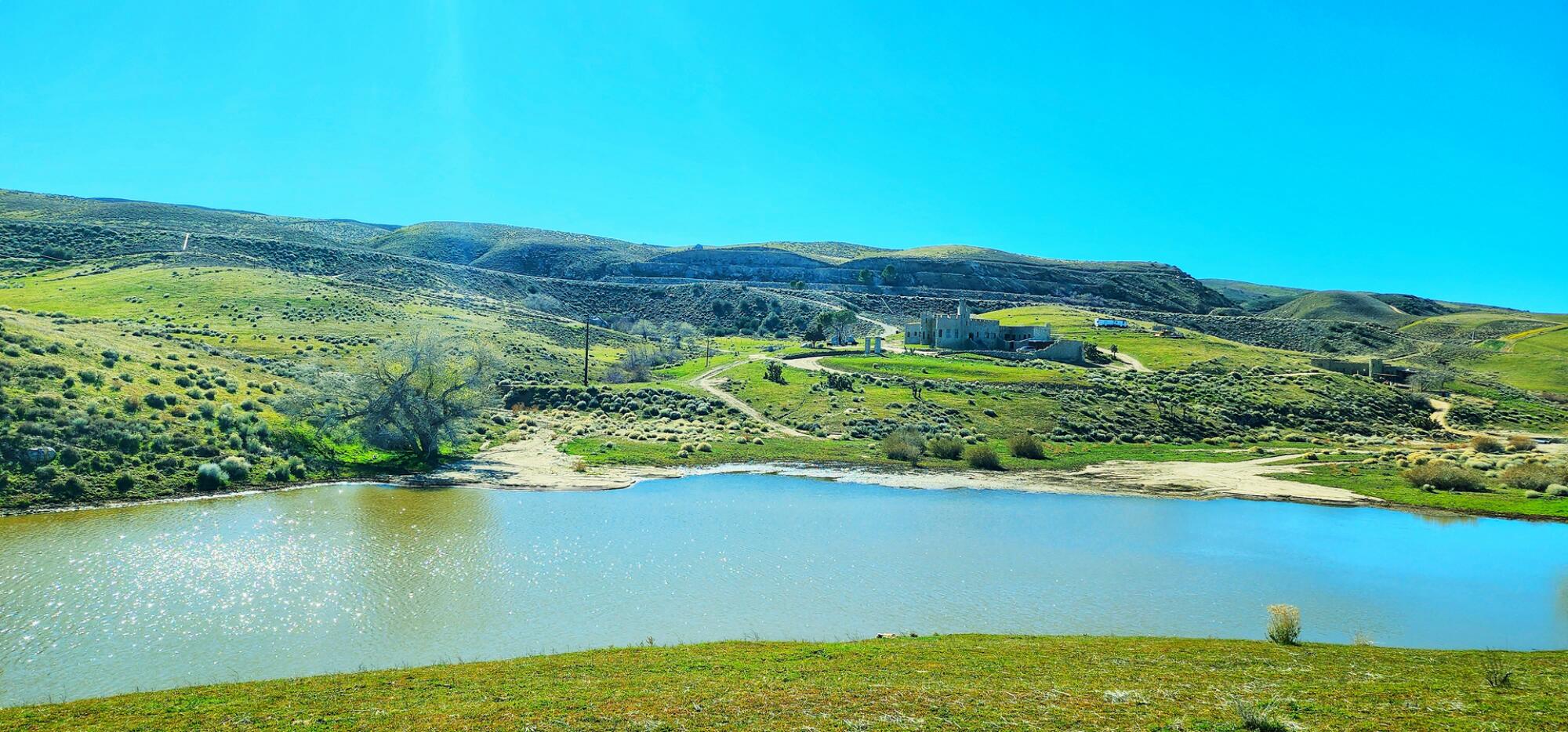
Nia Castle sits on more than 500 acres in Del Sur, an unincorporated community in the Mojave Desert.
(Wardour Studios)
“Calabasas is more refined, but the raw, basic nature of this place is more fascinating,” Nia said.
The majestic estate, which looks straight out of a medieval period drama, cost just over $2 million. Nia and Leo spend more time there than Calabasas. When they’re back in Calabasas, they rent out the castle for film shoots.
Tunku Dato Ya’acob Khyra, a member of the Malaysian royal family, started shopping for a California home in 2016. He looked at Beverly Hills and Santa Barbara, and his multimillion-dollar budget could’ve bought him a decent place in most markets around L.A.
Instead, he landed in Cherry Valley, a small enclave nestled below the San Bernardino National Forest. Khyra paid $1.47 million for a massive estate in a community with an average median listing price of $375,000.
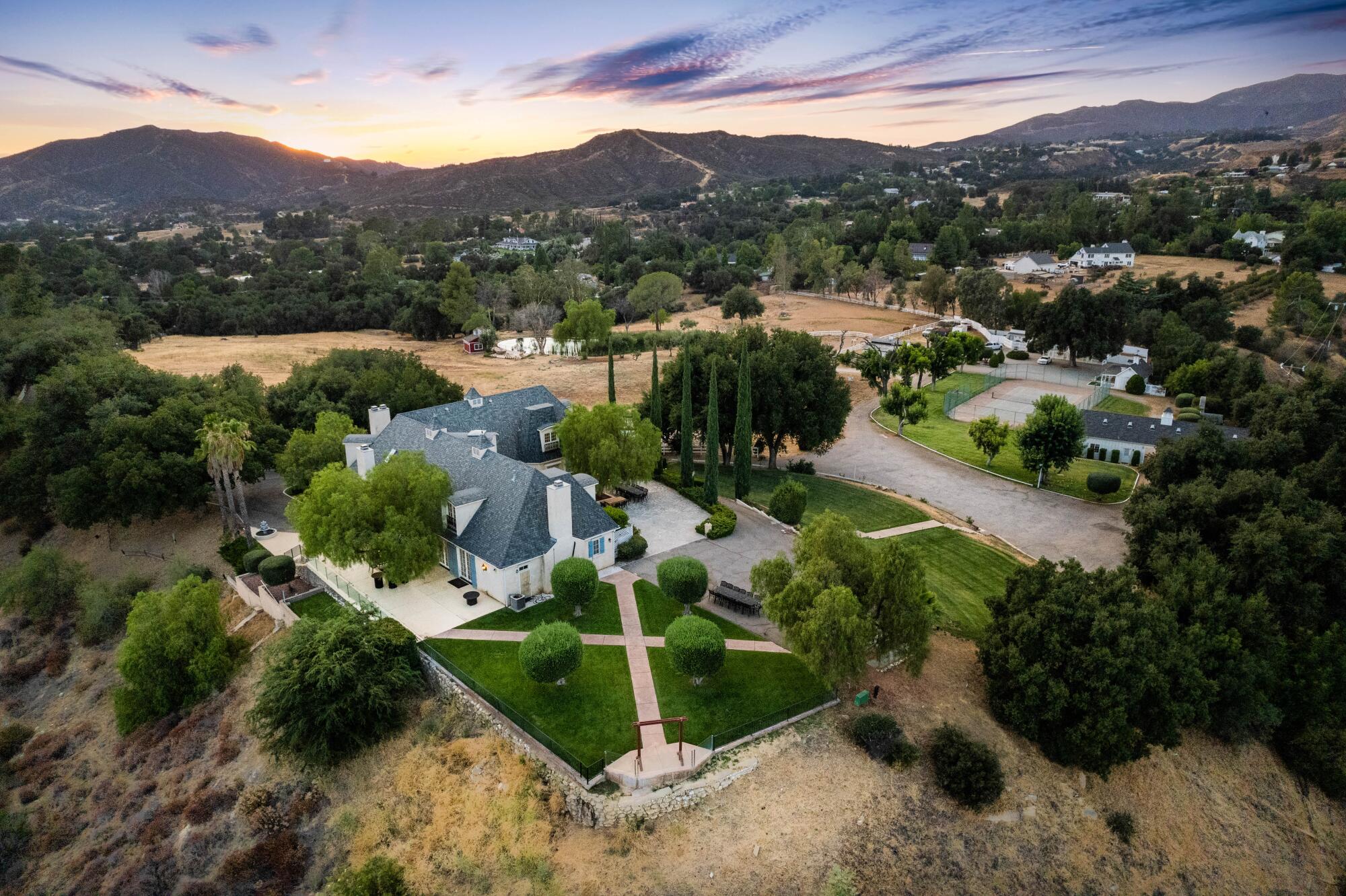
This Cherry Valley manor sold for $1.47 million.
(L.A. Real Estate Agency)
It was far less than he originally planned to spend, and what he got would’ve cost 10 times as much in L.A.
The property is a compound, spanning 15 acres overlooking Mt. San Gorgonio. It centers on a three-story French-inspired mansion, complete with eight bedrooms and nine bathrooms. It also includes seven cottages, each with their own bathroom, kitchen and patio, as well as a swimming pool, tennis court and fishing pond.
The $1.47-million home is big enough to house his entire family, including seven children, as well as additional caretakers. For the same price in L.A., he could have bought a 600-square-foot condo in Venice, or an empty piece of land in Highland Park.
“The sense of autonomy, freedom and privacy you get when you live on 15 acres is hard to describe,” Khyra said. “This property is simply the biggest and best property in the entire county.”
Credit: Source link
